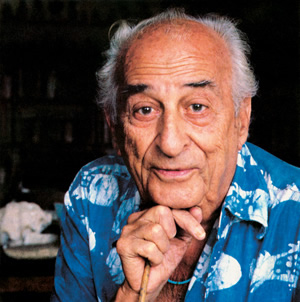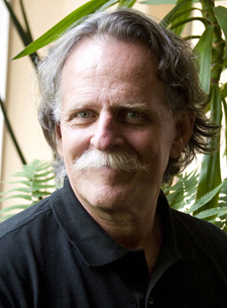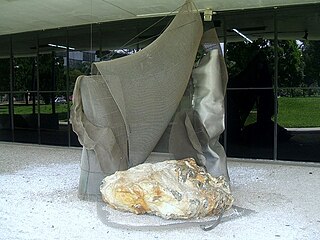Related Research Articles

Alfons Hug is a curator, critic and exhibition organizer.
Brígida Baltar was a Brazilian visual artist. Her work spanned across a wide range of mediums, including video, performance, installation, drawing, and sculpture. She was interested in capturing the ephemeral in her artwork.

Héctor Julio Páride Bernabó was an Argentine-Brazilian artist, researcher, writer, historian and journalist. His nickname and artistic name, Carybé, a type of piranha, comes from his time in the scouts. He died of heart failure after the meeting of a candomblé community's lay board of directors, the Cruz Santa Opô Afonjá Society, of which he was a member.
Albuquerque Mendes is a Portuguese artist. He works in the fields of painting, performance art and installation.
Roberto Cabot is a Brazilian visual artist.

Gretta Sarfaty, born Alegre Sarfaty, is also known as Gretta Grzywacz and Greta Sarfaty Marchant, also simply as Gretta. is a painter, photographer and multimedia artist who earned international acclaim in the 1970s, from her artistic works related to Body art and Feminism. Born in Greece, in 1947, she moved with her family to São Paulo in 1954, being naturalized as Brazilian.

Claudio Edinger is a Brazilian photographer born in Rio de Janeiro in 1952. He lived in New York from 1976 to 1996.

Francisco Tropa is a Portuguese sculptor and visual artist. He lives and works in Lisbon.

Iole Antunes de Freitas is a Brazilian sculptor, engraver, and installation artist who works in the field of contemporary art. Freitas began her career in the 1970s, participating in a group of artists in Milan, Italy linked to Body art. She used photography. In the 1980s, she returned to Brazil, but abandoned the human body as mediator of her work, adopting the "sculpture body". The artist uses materials such as wire, canvas, steel, copper, stone, and water to create her works.

Sheila Leirner is a French Brazilian curator, journalist, and art critic, as well as a writer. She was chief curator of the XVIII and XIX São Paulo Art Biennials.
Guilherme Dable is a Brazilian artist who lives and works in Porto Alegre. He had his MFA from Universidade Federal do Rio Grande do Sul Art Institute in 2012, having graduated there in drawing in 2009. Guilherme Dable’s films The Tamer and The radio was always on in the kitchen are part of Museum of Modern Art, Rio de Janeiro’s permanent collection, 2016. Guilherme also has paintings in the above-mentioned collection on permanent loan from Gilberto Chateaubriand.
Maria Lynch is a Brazilian artist.
Gisele Camargo was born on July 11, 1970, in Rio de Janeiro, Brazil. She is a Brazilian painter and photographer who works in photography, video, and painting. She is best known for her pictorial meditations on urban and cinematic landscapes. She was formally trained at the Escola de Belas-Artes (EBA) of the Universidade Federal do Rio de Janeiro in the late 1990s. While in the institution, Camargo was part of a group of students who concentrated on issues of urban experience and visual culture in Rio de Janeiro. Camargo was different from the rest of her classmates, while they engaged mostly with multimedia language she remained a painter, with sporadic forays into photography and photocollage.
Dudi Maia Rosa is a Brazilian artist.
Waldemar Cordeiro was an Italian-born Brazilian art critic and artist. He worked as a computer artist in the early days of computer art and was a pioneer of the concrete art movement in Latin America.
Hércules Rubens Barsotti was a Brazilian painter, graphic designer, scenographer and costume designer. He was a member of the Neo-Concrete Movement.
Judith Lauand was a Brazilian painter and printmaker. She is considered a pioneer of the Brazilian modernist movement that started in the 1950s, and was the only female member of the concrete art movement based in São Paulo, the Grupo Ruptura.
Juliana Scotá Stein is a visual artist and photographer. She graduated in Psychology from Universidade Federal do Paraná (UFPR) in 1992 and lived in Florence and Venice where she studied art. She continued to work with photography during the 1990s, developing her craft.

Wanda Pimentel was a Brazilian painter, based in Rio de Janeiro, Brazil. Her work is distinguished by "a precise, hard-edge quality encompassing geometric lines and smooth surfaces in pieces that often defy categorization as abstract or figurative. “My studio is in my bedroom,” Pimentel said in an interview. “Everything has to be very neat. .. I work alone. I think my issues are the issues of our time: the lack of perspective for people, their alienation. The saddest thing is for people to be dominated by things.”
Mara Alvares is a Brazilian artist. She mainly specialized in photography as one of her notable works is the Adansônia. She first studied metal engraving with the Universidade Federal do Rio Grande do Sul with Iberê Camargo.
References
- ↑ "The Brooklyn Museum Presents the Critically Acclaimed Exhibition Radical Women: Latin American Art, 1960–1985" (PDF). Brooklyn Museum . December 2017. Archived from the original on 15 July 2021.
- ↑ Fajardo-Hill, Cecilia; Guerrero, Marcela (2017). "Latina Art Through the Exhibition Lens: Radical Women: Latin American Art, 1960–1985". Diálogo. 20 (1): 133–140. doi:10.1353/dlg.2017.0015. ISSN 2471-1039. S2CID 149187408.
- ↑ "Body Landscape / El cuerpo en paisaje | Radical Women digital archive". Hammer Museum. Retrieved 2019-03-11.
- 1 2 Radical women : Latin American art, 1960–1985. Fajardo-Hill, Cecilia,, Giunta, Andrea,, Alonso, Rodrigo,, Armand Hammer Museum of Art and Cultural Center,, Brooklyn Museum,, Pacific Standard Time: LA/LA (Project). Los Angeles. 2017. ISBN 9783791356808. OCLC 982089637.
{{cite book}}: CS1 maint: others (link) - 1 2 "Vera Chaves Barcellos" (in Portuguese).
- 1 2 3 "Vera Chaves Barcellos | Radical Women digital archive". Hammer Museum. Retrieved 2019-03-11.
- 1 2 "Vera Chaves Barcellos". Fundação Vera Chaves Barcellos (in Portuguese).
- ↑ Hammer Museum (2017-12-01), Radical Women: Vera Chaves Barcellos , retrieved 2019-03-10
- ↑ "DIVERSIONS AND/OR THE ORIGINALITY OF COPIES". www.verachaves.com. Retrieved 2019-03-11.
- ↑ "Images in Migration, Vera Chaves Barcellos interviewed by Gloria Ferreira". www.verachaves.com. Retrieved 2019-03-11.
- 1 2 3 "Uma obra contemporânea de seu tempo". www.verachaves.com. Retrieved 2019-03-11.
- 1 2 "Installations". www.verachaves.com. Retrieved 2019-03-11.
- ↑ "A Work of Art Contemporaneous of Its Time". www.verachaves.com. Retrieved 2019-03-11.
- ↑ "La opción de un artista por determinado medio o procedimiento se constituye en la materialización de un proceso mental y crea". www.verachaves.com. Retrieved 2019-03-10.
- ↑ "Installations-Memorial III". www.verachaves.com. Retrieved 2019-03-11.
- ↑ "Installations-IV". www.verachaves.com. Retrieved 2019-03-11.
- ↑ "Installations-V". www.verachaves.com. Retrieved 2019-03-11.
- ↑ "Vera Chaves Barcellos – 19th Contemporary Art Festival Sesc_Videobrasil". 19º Festival de Arte Contemporânea Sesc_Videobrasil. Retrieved 2019-03-10.
- ↑ "Recent works". www.verachaves.com. Retrieved 2019-02-04.
- 1 2 "Biography". www.verachaves.com. Retrieved 2019-03-11.
- ↑ "FVCB » Currículo" (in Brazilian Portuguese). Retrieved 2019-03-11.
- ↑ "Vera Chaves Barcellos Resultados da pesquisa". MAM (in Brazilian Portuguese). Retrieved 2019-03-11.
- ↑ "ICAA Documents > THE ARCHIVE > Full Record". icaadocs.mfah.org. Retrieved 2019-03-11.
- ↑ "FVCB » Vera Chaves Barcellos: A Respeito do Sorriso" (in Brazilian Portuguese). Retrieved 2019-03-11.